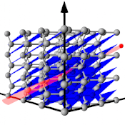Crystalline coherence
When a very strong electromagnetic field interacts with an atom, the usual picture of energy levels breaks down. Instead, the states of the atom must be considered an intimately coupled system of atom + photons. If a two-level system of these so-called “dressed” states interacts with a third level by absorbing or emitting photons, then the spectrum can show an energy level splitting called Autler-Townes doublets.
As Y. Nakai et al. report in Physical Review Letters, however, these spectral effects do not only occur in strong optical fields—atoms flying through a crystal lattice can experience the same splitting. The research team shot ions through a single crystal of silicon at different angles relative to the crystal planes. The ions pass through the spatially periodic field created by the silicon atoms in the crystal lattice, but in the moving reference frame of the ions, the crystal field looks like a time varying field. By carefully choosing the angle that the ions pass through the crystal, the researchers could generate two different frequency components of the moving field to create the needed double resonance.
Nakai et al. were able to detect the coherent excitation of the ions by the crystal field in the fraction of that survived the journey: successful excitation meant that an ion would be subsequently further ionized to and higher by collisions with silicon atoms. Distinct Autler-Townes doublet dips in the survival fraction were observed as the excitation energy was varied. The results offer a new method for manipulating atomic state populations in energy ranges where optical sources are difficult to find. – David Voss





